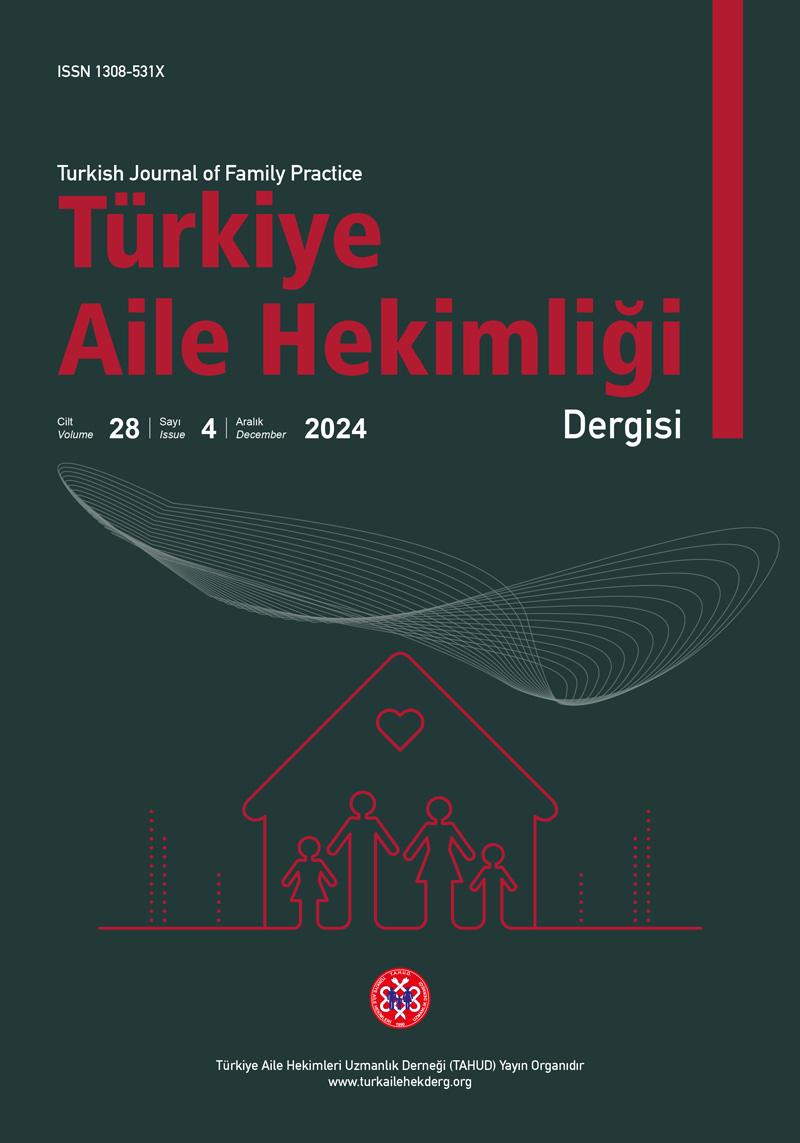Öz
Amaç: COVID-19 ile yaygın viral hepatitler olan HBV ve HCV enfeksiyonlarının birbirinin seyrini ne şekilde etkilediği kesin olarak bilinmemektedir. COVID-19 hastalarının tedavisinde kullanılan ilaçların karaciğer üzerine etkileri ve Hepatit B enfeksiyonu taşıyan hastalarda akut hepatik alevlenme riski araştırılması gereken bir diğer konudur. Tüm bu nedenler, COVID-19 ile HBV ve HCV enfeksiyonlarının ilişkisinin araştırılmasını gerektirmektedir. Bu çalışmanın amacı, COVID-19 tanılı hastalarda Hepatit B ve Hepatit C enfeksiyonlarının seroprevalansını belirlemek ve hastaların klinik özelliklerini değerlendirmektir.
Yöntem: Bu çalışma kesitsel bir prevalans çalışmasıdır. Çalışmaya 1 Ocak-30 Haziran 2021 tarihleri arasında üniversite hastanesinin COVID-19 polikliniğine başvuran ve PCR testi pozitif bulunan, 18 yaşın üzerinde 1026 hasta dahil edildi. Katılımcılara çalışmanın içeriği hakkında sözel bilgi verildi ve yazılı onamları alındı. Araştırmacı tarafından kişisel bilgi formu yüz yüze görüşülerek uygulandı. COVID poliklinik hemşireleri tarafından venöz kan örneği alınarak Hepatit B yüzey antijeni (HBsAg), Anti HBs, hepatit B çekirdek antikoru (Anti-HBc IgG), Anti HCV, aspartat aminotransferaz (AST), alanin aminotransferaz (ALT), gama glutamil transpeptidaz (GGT), total bilirubin, direk bilirubin, indirek bilirubin ve hemogram değerleri çalışıldı. Verilerin istatistiksel analizi IBM SPSS Statistics sürüm 20 paket programı ile yapıldı. Gruplar arasında karşılaştırmalar için Kruskal-Wallis H ve Mann-Whitney U testleri kullanıldı. İstatistiksel anlamlılık p<0,05 olarak kabul edildi.
Bulgular: Katılımcıların yaş ortalaması 45,11±16,12; %53,6’sı (n=550) kadın, %30,0’u (n=308) lise mezunu, %25,7’si (n=264) ev hanımıdır. Hastalarda öksürük %39,9; halsizlik %34,3 ve ateş %26,1 en sık belirtilen klinik şikâyetti. Katılımcıların %55,4’ünün bilinen kronik bir hastalığı yoktu. En sık görülen kronik hastalık %19,3 ile hipertansiyondu. PCR testi pozitif olan hastalarda HBsAg, anti-HCV, anti-HBs ve Anti-HBc IgG için seropozitiflik oranları sırasıyla %1,4 (n=14/1026); %0,5 (n=5/1026); %48,5 (n=498/1026); %18,2 (n=187/1026) olarak bulundu. Hastaların hepatit seroloji sonuçları cinsiyete göre karşılaştırıldığında kadınlarda Anti HBs negatifliği erkeklerden daha yüksek olarak bulundu (p=0,034).
Sonuç: COVID-19 tanılı hastalarda HBV ve HCV seropozitifliği ülkemiz ve bölgemizdeki seroprevalans çalışmaları ile karşılaştırıldığında normal popülasyondan düşük bulundu. Bu veriye dayanarak, kronik viral hepatitlerin COVID-19 için primer risk faktörü olmadığı düşünülebilir. Ancak bu düşünceyi kesin olarak kanıtlamak ve COVID-19 ve viral hepatitler arasındaki etkileşimi göstermek için daha detaylı yeni çalışmalara gereksinim vardır.
Anahtar Kelimeler: COVID-19, Hepatit B enfeksiyonu, Hepatit C enfeksiyonu, Seroprevalans
Referanslar
- Cascella M, Rajnik M, Aleem A, Dulebohn SC, Napoli RD. Features, evaluation, and treatment of coronavirus (COVID-19). https://www.ncbi.nlm.nih.gov/books/NBK554776/ adresinden 17/03/2023 tarihinde erişilmiştir.
- Asselah T, Durantel D, Pasmant E, Lau G, Schinazi RF. COVID-19: Discovery, diagnostics and drug development. J Hepatol. 2021;74(1):168-84.
- Stokes EK, Zambrano LD, Anderson KN, et al. Coronavirus Disease 2019 Case Surveillance - United States, January 22-May 30, 2020. MMWR Morb Mortal Wkly Rep. 2020;69(24):759-65.
- Pascarella G, Strumia A, Piliego C, et al. COVID-19 diagnosis and management: A comprehensive review. J Intern Med. 2020;288(2):192-206.
- Jothimani D, Venugopal R, Abedin MF, Kaliamoorthy I, Rela M. COVID-19 and the liver. J Hepatol. 2020;73(5):1231-40.
- Xu L, Liu J, Lu M, Yang D, Zheng X. Liver injury during highly pathogenic human coronavirus infections. Liver Int. 2020;40(5):998-1004.
- Chai X, Hu L, Zhang Y, et al. Specific ACE2 expression in cholangiocytes may cause liver damage after 2019-nCoV infection. bioRxiv [Preprint]. 2020. https://doi.org/10.1101/2020.02.03.931766 adresinden erişilmiştir.
- Shepard CW, Simard EP, Finelli L, Fiore AE, Bell BP. Hepatitis B virus infection: Epidemiology and vaccination. Epidemiol Rev. 2006;28:112-25.
- World Health Organization (WHO). Global Hepatitis Report, 2017. https://www.who.int/publications/i/item/global-hepatitis-report-2017 adresinden 17/03/2023 tarihinde erişilmiştir.
- Tozun N, Ozdogan O, Cakaloglu Y, et al. Seroprevalence of hepatitis B and C virus infections and risk factors in Turkey: A fieldwork TURHEP study. Clin Microbiol Infect. 2015;21(11):1020-6.
- Avcı I. Kan ve vücut sıvıları ile bulaşan enfeksiyonlar. In: Kurt H, Gündeş S, Geyik F. editors. Enfeksiyon Hastalıkları. İstanbul: Nobel Tıp; 2013:203-5.
- He YF, Jiang ZG, Wu N, Bian N, Ren JL. Correlation between COVID-19 and hepatitis B: A systematic review. World J Gastroenterol. 2022;28(46):6599-618.
- Alqahtani SA, Buti M. COVID-19 and hepatitis B infection. Antivir Ther. 2020;25(8):389-97.
- Ronderos D, Omar AMS, Abbas H, et al. Chronic hepatitis-C infection in COVID-19 patients is associated with in-hospital mortality. World J Clin Cases. 2021;9(29):8749-62.
- Yip TCF, Gill M, Wong GLH, Liu K. Management of hepatitis B virus reactivation due to treatment of COVID-19. Hepatol Int. 2022;16(2):257-68.
- Kazmi SK, Khan FMA, Natoli V, et al. Viral hepatitis amidst COVID-19 in Africa: Implications and recommendations. J Med Virol. 2022;94(1):7-10.
- Tekin S, Sümer Ş, Demirtürk N, Aygen B. Chronic hepatitis C in the pandemic. Klimik Derg. 2021;34(1):13-7.
- Zhu JH, Peltekian KM. HBV coinfection and in-hospital outcomes for COVID-19: A systematic review and meta-analysis. Can Liver J. 2021;4(1):16-22.
- Demirtürk N, Demirdal T, Toprak D, Altindiş M, Aktepe OC. Hepatitis B and C virus in West-Central Turkey: Seroprevalence in healthy individuals admitted to a university hospital for routine health checks. Turk J Gastroenterol. 2006;17(4):267-72.
- Guan WJ, Ni ZY, Hu Y, et al. Clinical Characteristics of Coronavirus Disease 2019 in China. N Engl J Med. 2020;382(18):1708-20.
Telif hakkı ve lisans
Telif Hakkı © 2024 Yazar(lar). Açık erişimli bu makale, orijinal çalışmaya uygun şekilde atıfta bulunulması koşuluyla, herhangi bir ortamda veya formatta sınırsız kullanım, dağıtım ve çoğaltmaya izin veren Creative Commons Attribution License (CC BY) altında dağıtılmıştır.










